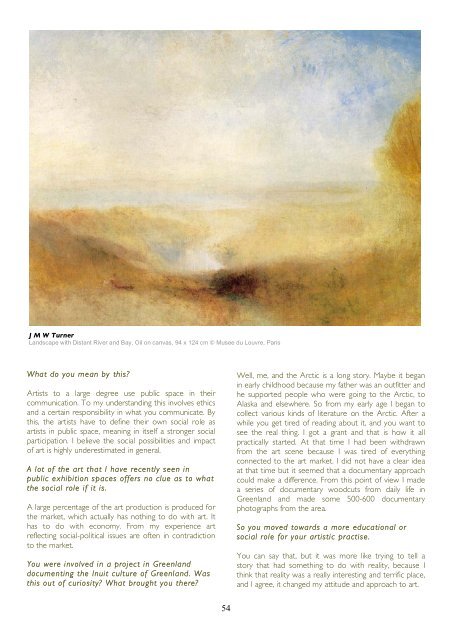M - Antennae The Journal of Nature in Visual Culture
M - Antennae The Journal of Nature in Visual Culture
M - Antennae The Journal of Nature in Visual Culture
Create successful ePaper yourself
Turn your PDF publications into a flip-book with our unique Google optimized e-Paper software.
J M W Turner<br />
Landscape with Distant River and Bay, Oil on canvas, 94 x 124 cm � Musee du Louvre, Paris<br />
What do you mean by this?<br />
Artists to a large degree use public space <strong>in</strong> their<br />
communication. To my understand<strong>in</strong>g this <strong>in</strong>volves ethics<br />
and a certa<strong>in</strong> responsibility <strong>in</strong> what you communicate. By<br />
this, the artists have to def<strong>in</strong>e their own social role as<br />
artists <strong>in</strong> public space, mean<strong>in</strong>g <strong>in</strong> itself a stronger social<br />
participation. I believe the social possibilities and impact<br />
<strong>of</strong> art is highly underestimated <strong>in</strong> general.<br />
A lot <strong>of</strong> the art that I have recently seen <strong>in</strong><br />
public exhibition spaces <strong>of</strong>fers no clue as to what<br />
the social role if it is.<br />
A large percentage <strong>of</strong> the art production is produced for<br />
the market, which actually has noth<strong>in</strong>g to do with art. It<br />
has to do with economy. From my experience art<br />
reflect<strong>in</strong>g social-political issues are <strong>of</strong>ten <strong>in</strong> contradiction<br />
to the market.<br />
You were <strong>in</strong>volved <strong>in</strong> a project <strong>in</strong> Greenland<br />
document<strong>in</strong>g the Inuit culture <strong>of</strong> Greenland. Was<br />
this out <strong>of</strong> curiosity? What brought you there?<br />
54<br />
Well, me, and the Arctic is a long story. Maybe it began<br />
<strong>in</strong> early childhood because my father was an outfitter and<br />
he supported people who were go<strong>in</strong>g to the Arctic, to<br />
Alaska and elsewhere. So from my early age I began to<br />
collect various k<strong>in</strong>ds <strong>of</strong> literature on the Arctic. After a<br />
while you get tired <strong>of</strong> read<strong>in</strong>g about it, and you want to<br />
see the real th<strong>in</strong>g. I got a grant and that is how it all<br />
practically started. At that time I had been withdrawn<br />
from the art scene because I was tired <strong>of</strong> everyth<strong>in</strong>g<br />
connected to the art market. I did not have a clear idea<br />
at that time but it seemed that a documentary approach<br />
could make a difference. From this po<strong>in</strong>t <strong>of</strong> view I made<br />
a series <strong>of</strong> documentary woodcuts from daily life <strong>in</strong><br />
Greenland and made some 500-600 documentary<br />
photographs from the area.<br />
So you moved towards a more educational or<br />
social role for your artistic practise.<br />
You can say that, but it was more like try<strong>in</strong>g to tell a<br />
story that had someth<strong>in</strong>g to do with reality, because I<br />
th<strong>in</strong>k that reality was a really <strong>in</strong>terest<strong>in</strong>g and terrific place,<br />
and I agree, it changed my attitude and approach to art.












